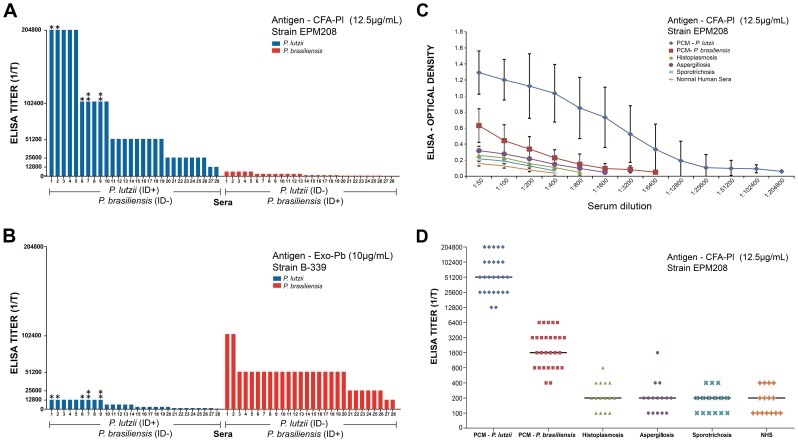Figure 5. A) Individual serum ELISA titers (1/T) of 28 sera from patients with PCM due to P. lutzii (blue) compared to individual serum ELISA titers (1/T) of 28 sera from patients with PCM due to P. brasiliensis (red) reacting with Ag CFA-Pl EPM 208 (12.5 µg/ml).
The P. lutzii sera presented ID + for P. lutzii CFA antigen and ID − for P. brasiliensis exoantigen (AgPbB339). The group of P. brasiliensis sera presented ID + for AgPbB339 antigen and ID − for P. lutzii CFA antigen. (*) represents P. lutzii gold standard serum and (**) represents sera that had a very weak cross reaction with P. brasiliensis exoantigen. B) Individual serum ELISA titers (1/T) of 28 sera from patients with PCM due to P. lutzii (blue) compared to individual serum ELISA titers (1/T) of 28 sera from patients with PCM due to P. brasiliensis (red) reacting with Ag Exo Pb B339 (10 µg/ml). The P. lutzii sera presented ID + for P. lutzii CFA antigen and ID − for P. brasiliensis exoantigen (AgPbB339). The group of P. brasiliensis sera presented ID + for AgPbB339 antigen and ID − for P. lutzii CFA antigen. (*) represents P. lutzii gold standard serum and (**) represents sera that had a very weak cross reaction with P. brasiliensis exoantigen. The same group of sera was used in A and B. C) ELISA median curves from sera from patients with PCM due to P. lutzii, PCM due to P. brasiliensis, and heterologous sera such as histoplasmosis, aspergillosis, sporotrichosis, and normal human serum. Antigen used was P. lutzii CFA (Ag CFA-Pl EPM 208 at 12.5 µg/ml). D) ELISA individual serum titers (1/T) of patients with PCM due to P. lutzii, P. brasiliensis, and heterologous sera such as Histoplasmosis, Aspergillosis, Sporotrichosis and normal human sera. By the end titer we could distinguish sera of PCM patients due to P. lutzii from sera of PCM due to P. brasiliensis and other mycotic diseases. Antigen used was P. lutzii CFA (Ag CFA-Pl EPM 208 at 12.5 µg/ml). Bars indicate the median.

